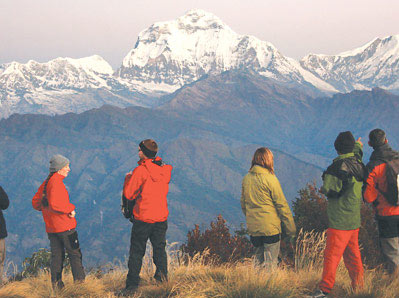

Arrivals up, but length of stay and spending down

Tourists have long flocked to Nepal to see the diversity of natural beauty. Adventure lovers have been attracted by a wide range of activities such as mountaineering, trekking and white-water rafting at the foot of the Himalayan range and home to the planet’s highest peaks.
In the last one decade, tourist arrivals in Nepal have jumped 137 percent to 803,092 in 2012. But, in a potentially damaging blow to the economy, there has been a sharp reduction in tourist length of stay and spending. According to government statistics, Nepal used to receive 338,132 tourists in 2003, and their average spending was $79.10 per day per person. In 2012, per day spending of a tourist has dropped to a 16-year low of $35.60.
In fact, experts and industry insiders say that promotional campaigns and branding of Nepal’s tourism has not been effective to lure high-end travellers. Lack of effective branding has also placed Nepal in the 112th spot among 140 countries in the tourism competitiveness index.
The Travel and Tourism Competitiveness Report 2013 (TTCR) published by the World Economic Forum shows that among the South Asian countries, Nepal is way below India and Sri Lanka that are 65th and 74th in the rankings, despite Nepal’s natural allure and being among the top 25 least restrictive destinations to visit.
Last week, Amitabh Kant, who is credited for leading the successful Incredible India campaign, anticipated that destination positioning and branding idea of Nepal is not effective, and this has cost Nepal to sell its products very cheaply. “There are few destinations like Nepal endowed with all natural gifts and has tremendous potential to grow. But Nepal needs to signify the gap between the performance and potential,” Kant said during a tourism conference here.
As the travelling habit of people in the world is changing gradually, Kant said that like in the past, seaside holidays and package holidays are not very popular among travellers now. “The travel scenario is shifting as industry is seeing more people being attracted to ecotourism.” Branding obviously plays a key role in promoting a destination as it inspires visitors to travel. In the context of Nepal, industry insiders say that Nepal has been selling the same brand since the last one decade. Presently Nepal has been branded under the slogan “Naturally Nepal-Once Is Not Enough”.
The TTCR shows that Nepal is ranked 78th in terms of effectiveness of marketing and branding to attract tourists. “Obviously, brands matter in the tourism market. And it’s also a fact that branding has a certain life,” says Aditya Baral, spokesperson of the Nepal Tourism Board, a body responsible for promoting Nepal in the domestic and global arenas. “We have been selling the same brand since the last seven-eight years, and the time has come to review it in line with the changing scenario,” says Baral.
Tourist perceptions of Nepal have too often been stereotyped with picturesque landscapes and Himalayan images. Although these perceptions have value, Nepal needs other perceptions that better recognize Nepal as a high-value destination, says Hari Sarmah, the CEO of the Nepal Association of Tour and Travel Agents (NATTA).
Tourism experts say that Nepal’s tourism industry earning could grow 20-fold to Rs 600 billion annually within the next five years from the current Rs 30 billion, if it is marketed as a high-value destination.
The tourism sector suffered a decline since 2001 when tourist arrivals dropped 23 percent to 275,468 in 2002. However, it started to pick up momentum when arrivals touched the 500,000 mark in 2007.
In 2010, the government, in coordination with the private sector, launched a campaign Nepal Tourism Year 2011 with a target to host 1 million tourists. Although the target was missed, it was considered successful in garnering political understanding among leaders who had committed not to organize strikes during the entire campaign.
However, scores of emerging problems like the airport not being up to the mark, poor performance of the national flag carrier, frequent air disasters, vulnerable road conditions, technology and poor internet access have become a major worrying factor to sustain growth in the upcoming days.
source: the kathmandu post,27 Sep 2013
photo: The Kathmandu post








